 |
QUICK SEARCH
MO PROJECTS:
Africa
Asia/Pacific
Mesoamerica
North America
South America
General Taxonomy
Photo Essays
Training in Latin
America
MO RESEARCH:
Wm. L. Brown Center
Bryology
GIS
Graduate Studies
Research Experiences
for Undergraduates
Imaging Lab
Library
MBG Press
Publications
Climate Change
Catalog Fossil Plants
MO DATABASES:
W³MOST
Image Index
Rare Books
Angiosperm
Phylogeny
Res Botanica
All Databases
INFORMATION:
What's New?
People at MO
Visitor's Guide
Herbarium
Jobs & Fellowships
Symposium
Research Links
Site Map
Search
The Prosoeca peringueyi (Diptera: Nemestrinidae) pollination guild in southern Africa: long-tongued flies and their tubular flowersFigure Captions 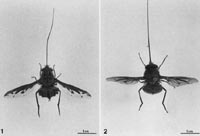 Figure 1 & 2. The Prosoeca species responsible for pollinating plant species with the Lapeirousia silenoides-type flower. 1. P. peringueyi. 2. P. sp. nov.
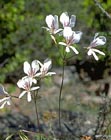
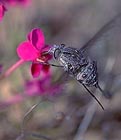
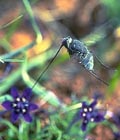
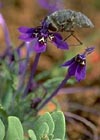 Figure 3-6. Prosoeca species foraging on Lapeirousia silenoides-type flowers. In these photogrpahs the flies are in the process of inserting their mouthparts into the floral tubes and have not yet probed deep enough to reach the nectar in the lower part of the tube or brush the anthers and stigmas of the flowers. 3. P. peringueyi visiting L. pyramidalis subsp. regalis. 4. P. peringueyi visiting L. silenoides. 5. P. peringueyi and L. silenoides. 6. P. sp. nov. and L. oreogena.
 Figure 7. Species of Geraniaceae belonging to the Lapeirousia silenoides guild, all pollinated by Prosoeca peringueyi. A. Pelargonium magenteum. B. P. sericifolium. C. P. incrassatum.

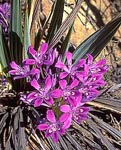 Figure 8. Species of Iridaceae belonging to the Lapeirousia silenoides guild pollinated (or inferred to be pollinated) by Prosoeca peringueyi. A. Babiana framesii. B. B. curviscapa. C. Lapeirousia pyramidalis subsp. regalis. D. L. dolomitica subsp. dolomitica. E. L. violacea. F. L. silenoides. G. Sparaxis variegata subsp. metelerkampiae. H. Tritonia marlothii.
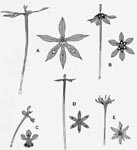
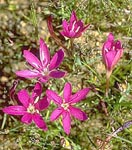 Figure 9. Species of Iridaceae belonging to the Lapeirousia silenoides guild pollinated (or inferred to be pollinated) by Prosoeca sp. nov. A. Babiana flabellifolia. B. Lapeirousia oreogena. C. L. jacquinii. D. Romulea hantamensis. E. Hesperantha oligantha.
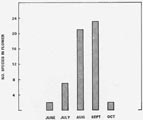 Figure 10. Flowering times of the plant species belonging to the Lapeirousia silenoides guild.
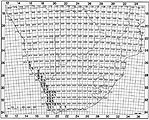 Figure 11. Map of southern Africa showing the distribution range of species with the Lapeirousia silenoides-type flower. Figures indicate the total number of species recorded per quarter degree square of geographical latitude and longitude.
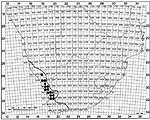 Figure 12. Map of southern Africa showing the distribution ranges of Prosoeca peringueyi (closed circles) and P. sp. (open circles) recorded on quarter degree squares of latitude and longitude. The combined ranges of plants species belonging to the guild pollinated by these two fly species is indicated by the heavy outline.
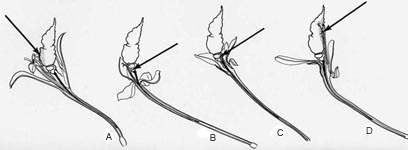 Figure 13. Differential placement of pollen on Prosoeca peringueyi. A. Babiana curviscapa, dorsum. B. Lapeirousia silenoides, frons. C. Pelargonium sericifolium, face. D. P. incrassatum, sternum (ventral thorax and abdomen). Hatching indicates the site of pollen deposition.
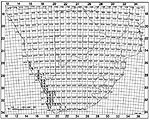 Figure 14. Map of southern Africa showing the differentiation of pollen loading sites. Figures indicate the number of different pollen-loading sites utilized by plant species per quarter degree square of geographical latitude and longitude. The total number of species occurring in each grid is indicated in Fig. 11.
|
© 1995-2025 Missouri Botanical Garden, All Rights Reserved
4344 Shaw Blvd.
St. Louis, MO 63110
(314) 577-5100
Technical Support